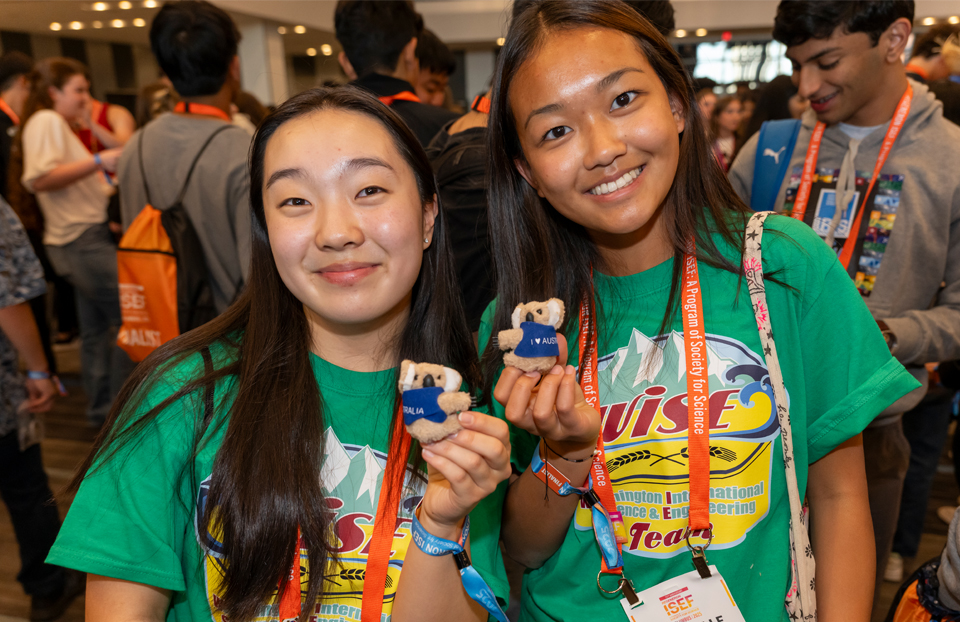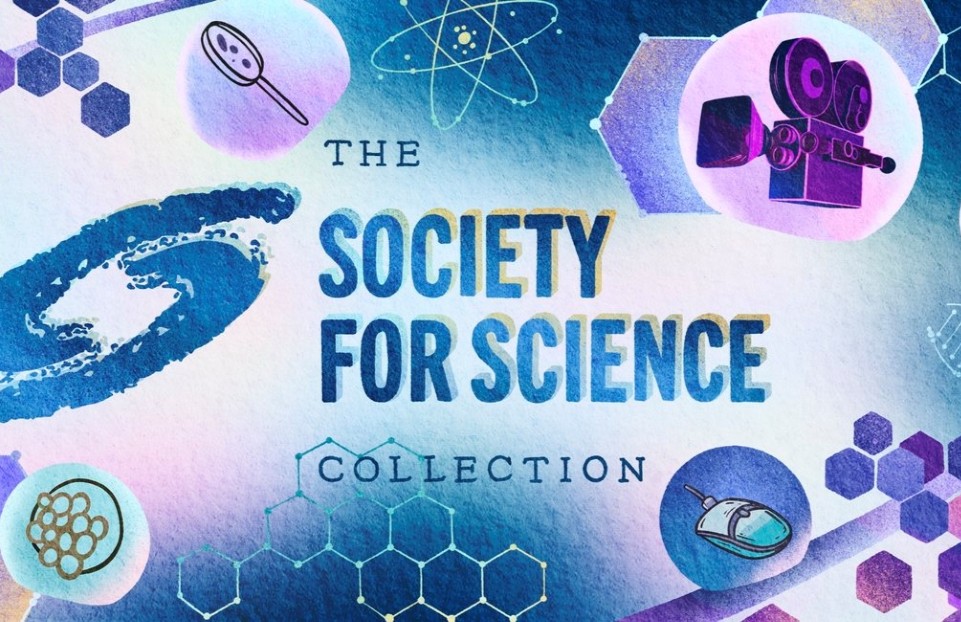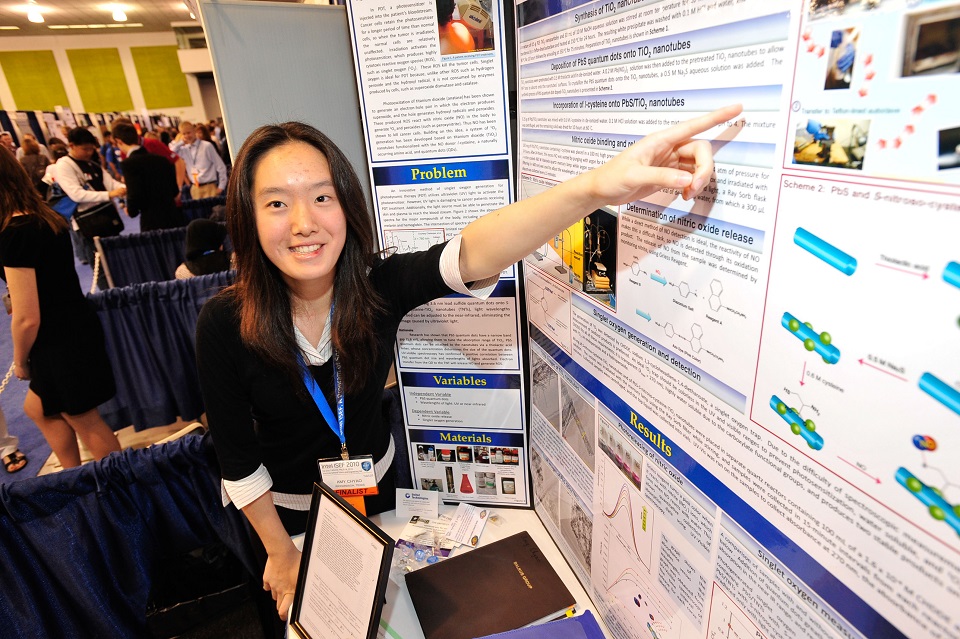Broadcom MASTERS International, ISEF
Students seek scientific solutions in Broadcom MASTERS International 2017 projects
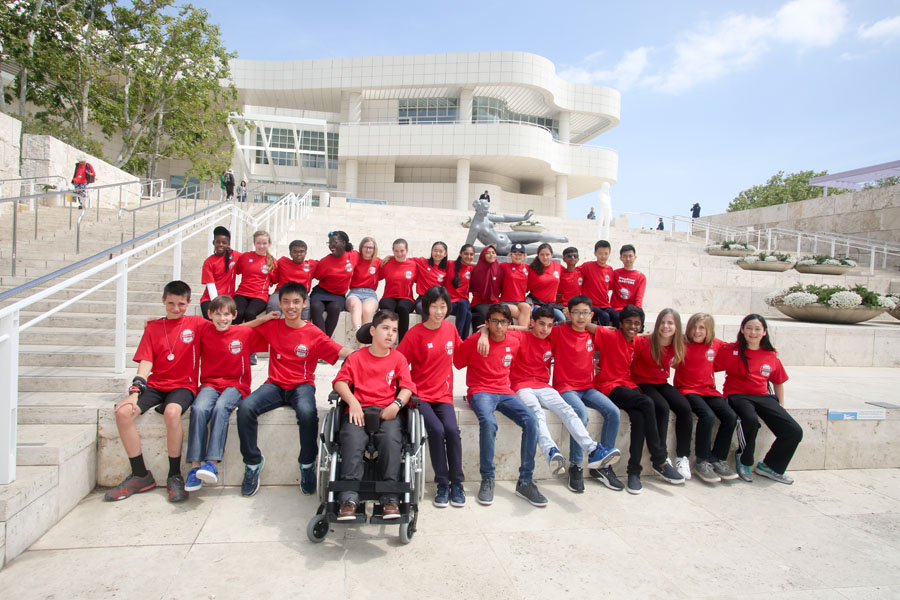
By Sophia Stuart
On May 17 at the J. Paul Getty Museum, 26 middle schoolers from 19 countries, all rising stars in math, applied science, technology and engineering, presented the projects that qualified them for the Broadcom MASTERS International program.
It was clear from the range of scholarship on display that despite their young age, the Broadcom MASTERS International cohort of 2017, called delegates, are determined to make changes in the world. From the podium in the Museum lecture hall, each delegate gave a polished elevator speech, highlighting salient points from their research, providing context, backstory, results, and inspiration behind the concept, as well as plans for what might be next.
Their projects ranged from rescue rockets to technology tidies for cables, via biotech clean water analysis, neuroscience and language learning, polar bears DNA and climate change, local vegetation exploration, and engineered voice-activated lunchboxes.
Because these students demonstrated the importance of service through science already — of what I like to call ‘bilateral activism’—it will open up so many more doors for them in the future.
Gordon Lindsay, former Applications Director at Broadcom Limited Europe, was at the event. Lindsay has been involved with Broadcom MASTERS International since it began in 2012 as part of the volunteer program staff, chaperoning young science stars from Canada, Israel, Puerto Rico, Singapore, and Taiwan.
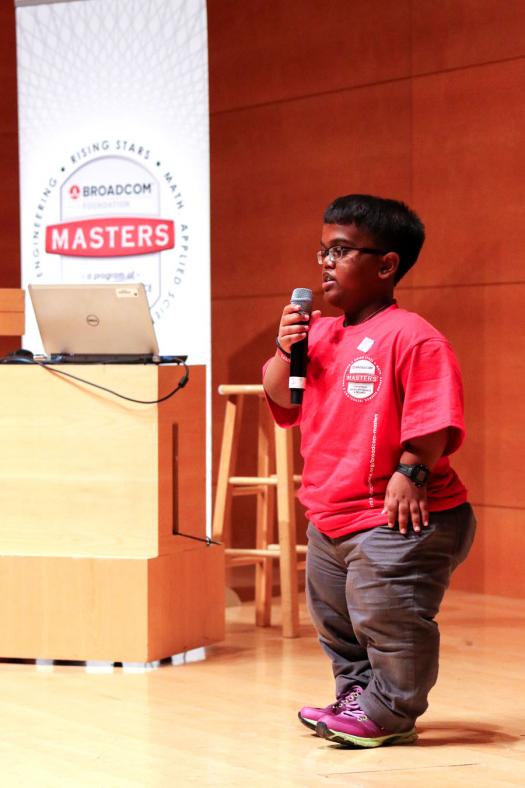
“It never ceases to amaze me, each year, the projects that they come up with,” said Lindsay. “Like sutures for heart surgery, and I think ‘How did they dream these up?’ When you delve into it there’s always a story — either a family connection or their locality gives rise to these issues that they want to help solve.”
This was certainly true of Razi Azulai,10, from Israel, as he headed up the ramp to the stage in his wheelchair, alongside his project partner Yoav Zohar, 13, also from Israel.
“I asked the students to make me a lunchbox so I could take out my sandwich by myself,” said Azulai, as a picture of their project was projected onto the massive screen at the Getty. Then he demonstrated how their “soundbox” project worked, using audio (voice and/or clapping) commands, picked up by a microphone inside, which sends a signal to the in-box motor, connecting a mechanism that springs open the lid.
It never ceases to amaze me, each year, the projects that they come up with.
Project partner Zohar explained, “At our school we have a program where 28 children, like Razi, have special needs and disabilities. Through the soundbox, they can open their lunchbox as easily and quickly as anyone else — granting them independence, building confidence, and removing frustration.”
He asked us to join him and Azulai in a live experiment. During their research stage, they’d recorded how long it took for fellow students with disabilities to open their lunchboxes. The average time was 10 seconds.
“Let’s pause for 10 seconds and see how long that feels,” he said.
It was a point well made. We all thought about how debilitating it would be to struggle for that amount of time, especially if young, surrounded by contemporaries, and hungry for our lunch.
The soundbox … allows students with disabilities to open their lunchbox as easily and quickly as anyone else.
“Through our soundbox we have reduced the wait time from 11.7 seconds down to 1.3 seconds,” Zohar said. “We have a limited lunch time so the time saved (by opening the box) gives the child more time to eat.”
It was a perfect blend of engineering, electronics, and social awareness. Many of the other projects also focused on socio-emotive themes, but some were more global in scope.
Sophia Cottrill, 14, from Canada, analyzed polar bear DNA and protein sequencing to determine how polar bears are uniquely distinct from other species. “There has been a 13 percent decline of sea ice per decade,” Cottrill pointed out and, due to the erosion of their habitat, polar bears face extinction if they don’t evolve. Rather than leave it there, Cottrill wanted evidence — a scientific mind at work, clearly — of whether the polar bear might adapt, and at what pace.
She gathered DNA sequencing information to plot a time graph of how long it took the polar bear to emerge in its current form. “However, evolution is so much slower than the rate of climate change,” she concluded. There was silence in the hall. But hopefully some young minds were inspired to study climatology as the result of her project.
Evolution is so much slower than the rate of climate change.
Leeloogonolo Victoria Msuma, 13, was concerned about her local area in South Africa, particularly on the impact of rodents on Marula seedlings, which are seeing a decline worldwide. Why? Because this directly concerns Nolo’s community. “If these trees go away, we will lose jobs, as soaps and body lotions are made from the Marula seedlings,” Msuma explained. Her project showed the trees are also home to birds and larger animals, as well as a source of fruit to eat, so their decline will disrupt not only the delicate eco-balance, but plunge the local economy into debt.
It was great to see students focus on change in their local area where they could see direct results of their scientific studies. In Indonesia, Malilya Finda Dwiputri, 12, decided to raise awareness of biodiversity and potential plant extinction. Her project increased awareness of local vegetation by an astonishing 70 percent amongst her test group by providing “herbarium vouchers” as a way of recording the plant life as scientific documents. She made the important point that caring about our future has to start with raising awareness of the natural world around us.
Caring about our future has to start with raising awareness of the natural world around us.
Plenty of the projects at Broadcom MASTERS International 2017 had practical applications, which one could see are ripe for commercial iteration.
Bohong Su, 14, from China, demonstrated his search-and-rescue mission engineering project. This could be used to save lives in elevated water levels locations, using a lightweight, long-range, high-precision water rocket affixed with a life vest attached to a rope.
James Fagan, 10, from the United States, has built not just one, but four wind tunnels to test his own observation drones. Fagan is looking forward to the NASA mission to Mars and presented his results from testing 18 airfoil designs at six different angles of trajectory for future aircraft. If NASA stays on schedule, and lunar-to-Mars missions start in 2030, Fagan may well be working there, once he finishes graduate school — as he’ll still only be 23 then.
Rather than pursue a thorough line of education, Clara Deehan, 15, from Northern Ireland, is already thinking of taking a sabbatical to pursue her engineering project before returning to higher education.
Like most entrepreneurs, her product started with a personal story. “After breaking my phone for the third time, I knew I had to do something,” she laughed, explaining that the twisty cords from all her electronic devices were unmanageable, and caused accidents.
She came up with a smart solution, creating a Mobile Phone Tidy, using 3D CAD Design program Solidworks, sending the file to a local laser cutter and manufacturing her prototype in acrylic because “It looks good, can be personalized, and recycled.” Clearly with a business brain on her shoulders, Deehan has estimated the cost of manufacturing at less than one dollar, with a potential retail sell-through of five dollars per unit. Plus, as she told us on stage at Broadcom MASTERS International, “There’s an endless market out there, due to the seven billion mobile phones worldwide.”
Commercial smarts aside, the delegates’ projects at Broadcom MASTERS International 2017 were all laudably rigorous in their evidence-based, process-led, science methodologies.
For example, Heviinash Parugavelu, 13, from Malaysia, shared his step-by-step research on water pollution. “Most rivers in my country are polluted,” he said. “But water is our life.” His solution was an electronic system to measure the turbidity of water in a simple, cost-effective, way to indicate water pollution levels. How? By using light. “If the water is clean, the light can pass through and be registered as ‘green’ (safe),” Paragavelu explained, so people can test their local water supply before risking the health of their families.
When you delve into it there’s always a story — either a family connection or their locality gives rise to these issues that they want to help solve.
In Egypt, Akram Elogili did his project because he was concerned about “Managing resources (in my country), as street lamps are using up precious energy stores.” He recommended switching out bulbs for energy efficient LED lamps and created an automatic lighting control circuit to manage them in a local area network. Elogili’s clever circuit uses sensors to detect daylight, switching off street lamps to save money. His project also used solar charging batteries and the circuit could be manufactured for less than $10.
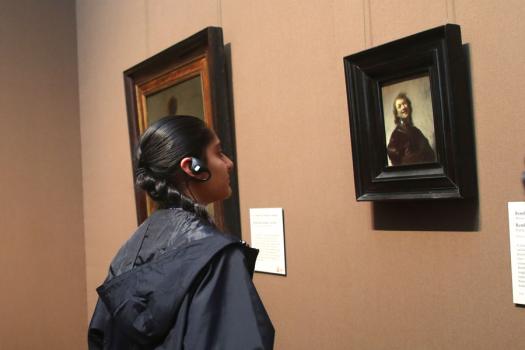
There were many other excellent projects, but the last word has to go to Anjolaoluwa Awe, 14, from the United Kingdom, who focused her energies on language attribution. As she explained, the neuroscientific benefits of learning several new languages (and she speaks five: English, French, Mandarin, Spanish, and Yoruba) include delaying aging due to increased plasticity in the brain. However, she pointed out that “one of the biggest problems in STEM collaboration is the language barrier.” While, due to her five languages, Awe can communicate with “One in four people on the planet” — most others cannot. So her science project studied styles of learning to ascertain the most effective in acquiring new language skills.
One of the biggest problems in STEM collaboration is the language barrier.
Her final conclusion? Awe recommended increased exposure to other cultures through immersion. “Listen to K-pop, watch telenovelas without subtitles, Skype with a tutor in China,” were just a few of her suggestions.
As the presentation portion of the program drew to a close, Parshva Bavishi, the Society for Science & the Public’s Broadcom MASTERS Program Manager, said he was pleased by the level of social awareness shown by students in their research. “Going into high school it becomes extremely competitive, doing tests, getting into college. Because these students demonstrated the importance of service through science already — of what I like to call ‘bilateral activism’ — it will open up so many more doors for them in the future.”
Read the first in the series of posts about Broadcom MASTERS International 2017
